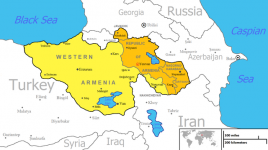United Armenia
Monday, February 14, 2022
United Armenia also known as Greater Armenia or Great Armenia, is an Armenian ethno-nationalist irredentist concept referring to areas within the traditional Armenian homeland—the Armenian Highland—which are currently or have historically been mostly populated by Armenians.
The idea of what Armenians see as unification of their historical lands was prevalent throughout the 20th century and has been advocated by individuals, various organizations and institutions, including the nationalist parties Armenian Revolutionary Federation (ARF or Dashnaktsutyun) and Heritage, the ASALA and others.
The ARF idea of "United Armenia" incorporates claims to Western Armenia (eastern Turkey), Nagorno-Karabakh (Artsakh), the landlocked exclave Nakhichevan of Azerbaijan and the Javakheti (Javakhk) region of Georgia. Nagorno-Karabakh and Javakhk are overwhelmingly inhabited by Armenians. Western Armenia and Nakhichevan had significant Armenian populations in the early 20th century, but no longer do. The Armenian population of Western Armenia was almost completely exterminated during the 1915 Armenian genocide, when the millennia-long Armenian presence in this region largely ended and Armenian cultural heritage was mainly destroyed by the Ottoman government. In 1919, the ARF-dominated government of the First Republic of Armenia declared the formal unification of Armenian lands. The ARF bases its claims to Western Armenia, now controlled by Turkey, on the 1920 Treaty of Sèvres, which was effectively negated by subsequent historical events. These territorial claims are often seen as the ultimate goal of the recognition of the Armenian Genocide and as part of Armenian genocide reparations.
The most recent Armenian irredentist movement, the Karabakh movement that began in 1988, sought to unify Nagorno-Karabakh with then-Soviet Armenia. As a result of the subsequent war with Azerbaijan, Armenian forces established effective control over most of Nagorno-Karabakh and the surrounding districts, thus succeeding in the de facto unification of Armenia and Karabakh. Some Armenian nationalists consider Nagorno-Karabakh "the first stage of a United Armenia."
In its current meaning, the term "United Armenia" was coined during the Armenian national awakening in the second half of the 19th century. During this period, the Armenian-populated areas were divided between the Russian Empire (Eastern Armenia) and the Ottoman Empire (Western Armenia). One of the earliest uses of the phrase "United Armenia" is by the English Society of Friends of Russian Freedom in an 1899 edition of Free Russia monthly. It quotes a confidential report of Grigory Golitsin (the Russian governor of the Caucasus) sent to Tsar Nicholas II "containing suggestions for a future policy." Golitsin writes of a nationalist movement which "aims at the restoration of the independent Armenia of the past", and that "their ideal is one great and united Armenia."
The idea of an independent and united Armenia was the main goal of the Armenian national liberation movement during the late nineteenth and early twentieth centuries. By the 1890s, a low-intensity armed conflict developed between the three major Armenian parties—the Armenian Revolutionary Federation (Dashnak), Hnchak and Armenakan— and the Ottoman government. Calls from the great powers for reforms in the Armenian provinces and Armenian aspirations to independence resulted in the Hamidian massacres between 1894 and 1896, during which up to 300,000 Armenian civilians were slaughtered by the order of Sultan Abdul Hamid II, after whom the massacres were named. After the 1908 Young Turk Revolution, some Armenians felt that the situation would improve; however, a year later the Adana massacre took place and Turkish-Armenian relations deteriorated further. After the Balkan Wars of 1912–1913, the Ottoman government was pressured to accept the Armenian reform package concerning the Armenian provinces in early 1914.





